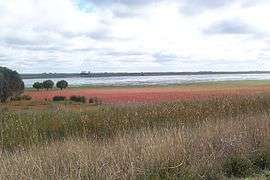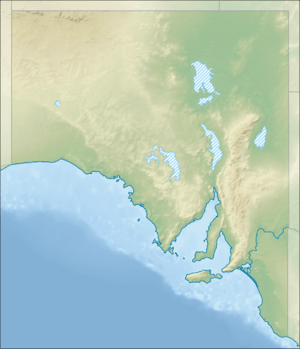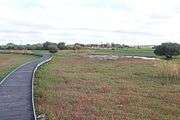Bool Lagoon Game Reserve
| Bool Lagoon Game Reserve South Australia | |
|---|---|
|
IUCN category VI (protected area with sustainable use of natural resources) | |
 Bool Lagoon. The red plant is samphire. | |
 Bool Lagoon Game Reserve | |
| Nearest town or city | Naracoorte[1] |
| Coordinates | 37°07′S 140°41′E / 37.117°S 140.683°ECoordinates: 37°07′S 140°41′E / 37.117°S 140.683°E |
| Established | 8 June 1967[2][3] |
| Area | 31.03 km2 (12.0 sq mi)[4] |
| Managing authorities | Department of Environment, Water and Natural Resources |
| Website | Bool Lagoon Game Reserve |
| Footnotes | |
| Official name | Bool and Hacks Lagoons |
| Designated | 1 November 1985 |
| Reference no. | 322[5] |
| See also | Protected areas of South Australia |
Bool Lagoon Game Reserve is a protected area located in the Limestone Coast region of South Australia, about 24 kilometres (15 miles) south of the town of Naracoorte.[1]
History
The game reserve began as land in sections 223 and 224 of the cadastral unit of the Hundred of Robertson which acquired protected area status on 8 June 1967 simultaneously as a game reserve declared under the Fauna Conservation Act, 1964-1965 and as a Fauna Conservation Reserve under the Crown Lands Act, 1929-1967 in association with land in section 249.[2][3] On 17 February 1972, section 356 was added to the game reserve.[6] On 27 April 1972 , land in sections 223 and 224 and 356 was reconstituted as the Bool Lagoon Game Reserve under the National Parks and Wildlife Act 1972.[7] In 1985, the area covered by both the game reserve and the Hacks Lagoon Conservation Park was added under the name "Bool and Hacks Lagoons" to the List of Wetlands of International Importance maintained by the Ramsar Convention.[8]
Ecology
While Bool Lagoon is officially a game reserve, in dry years it attracts a lot of waterbirds of many species, and is frequently a point of contention between duck hunters and animal rights activists. The adjacent Hacks Lagoon Conservation Park also provides refuge for waterbirds. There are a number of boardwalks and bird hides at both lagoons to facilitate birdwatching. The lagoons are visited by up to 150 species of birds, many having migrated from the Northern Hemisphere. The reserve is classified as an IUCN class VI protected area.[9]
Another ecological issue is that in the past, a lot of lead shot was used by hunters. In recent times, even when the lagoon is opened for hunting, only steel shot may be used.
Hydrology
Mosquito Creek flows into Hacks Lagoon, and any overflow flows into Bool Lagoon. Mosquito Creek used to continue out of Hacks Lagoon to spread out on the plains near Naracoorte, but is now blocked and any excess water is directed through a drain from Bool Lagoon to the coast near Beachport.
Gallery
 Bool Lagoon provides boardwalks and bird hides.
Bool Lagoon provides boardwalks and bird hides.
See also
References
- 1 2 "Bool Lagoon Game Reserve and Hacks Lagoon Conservation Park Management and Ramsar Plan" (PDF). Department for Environment and Heritage. 2006. pp. iii, 1, 2, 5 & 9. Retrieved 15 January 2015.
- 1 2 Walsh, Frank (8 June 1967). "FAUNA CONSERVATION ACT, 1964-1965: HUNDRED OF ROBERTSON—GAME RESERVE DECLARED" (PDF). The South Australian Government Gazette. South Australian government. p. 1746. Retrieved 23 September 2018.
- 1 2 Walsh, Frank (8 June 1967). "CROWN LANDS ACT, 1929-1967: HUNDRED OF ROBERTSON—FAUNA CONSERVATION RESERVE DEDICATED" (PDF). The South Australian Government Gazette. South Australian government. p. 1746. Retrieved 23 September 2018.
- ↑ "Protected Areas Information System Reserve List" (PDF). Government of South Australia. 9 March 2018. Retrieved 26 April 2018.
- ↑ "Bool and Hacks Lagoons". Ramsar Sites Information Service. Retrieved 25 April 2018.
- ↑ Shard, A.J. (17 February 1972). "FAUNA CONSERVATION ACT, 1964-1965" (PDF). The South Australian Government Gazette. South Australian government. p. 575. Retrieved 23 September 2018.
- ↑ "No. 56 of 1972 (National Parks and Wildlife Act, 1972)". The South Australian Government Gazette. Government of South Australia: 660, 703 & 704. 27 April 1972. Retrieved 23 September 2018.
- ↑ "Bool and Hacks Lagoons". Secretariat of the Ramsar Convention. Retrieved 12 March 2015.
- ↑ "CAPAD 2012 South Australia Summary (see 'DETAIL' tab)". CAPAD 2012. Australian Government - Department of the Environment. 6 February 2014. Retrieved 6 February 2014.